be动词和have动词的用法
- 格式:docx
- 大小:21.85 KB
- 文档页数:5
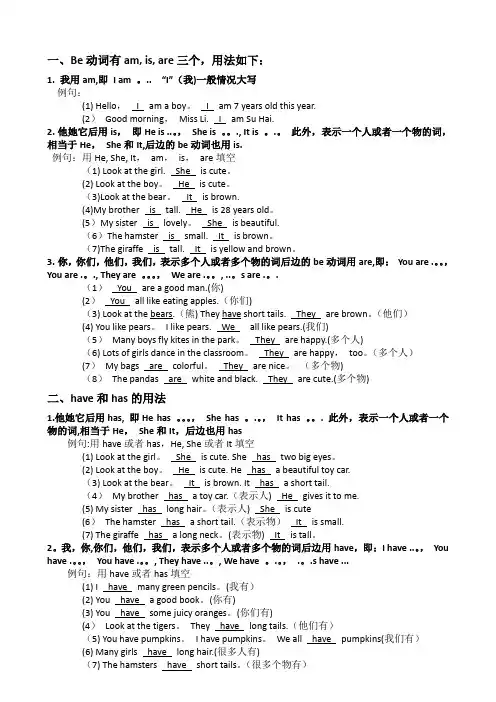
一、Be动词有am, is, are三个,用法如下:1. 我用am,即I am 。
.. “I”(我)一般情况大写例句:(1) Hello,I am a boy。
I am 7 years old this year.(2)Good morning,Miss Li. I am Su Hai.2.他她它后用is,即He is ..。
,She is 。
., It is 。
.。
此外,表示一个人或者一个物的词,相当于He,She和It,后边的be动词也用is.例句:用He, She, It,am,is,are填空(1) Look at the girl. She is cute。
(2) Look at the boy。
He is cute。
(3)Look at the bear。
It is brown.(4)My brother is tall. He is 28 years old。
(5)My sister is lovely。
She is beautiful.(6)The hamster is small. It is brown。
(7)The giraffe is tall. It is yellow and brown。
3.你,你们,他们,我们,表示多个人或者多个物的词后边的be动词用are,即:You are .。
,You are .。
., They are 。
,We are .。
, ..。
s are .。
.(1)You are a good man.(你)(2)You all like eating apples.(你们)(3) Look at the bears.(熊) They have short tails. They are brown。
(他们)(4) You like pears。
I like pears. We all like pears.(我们)(5)Many boys fly kites in the park。

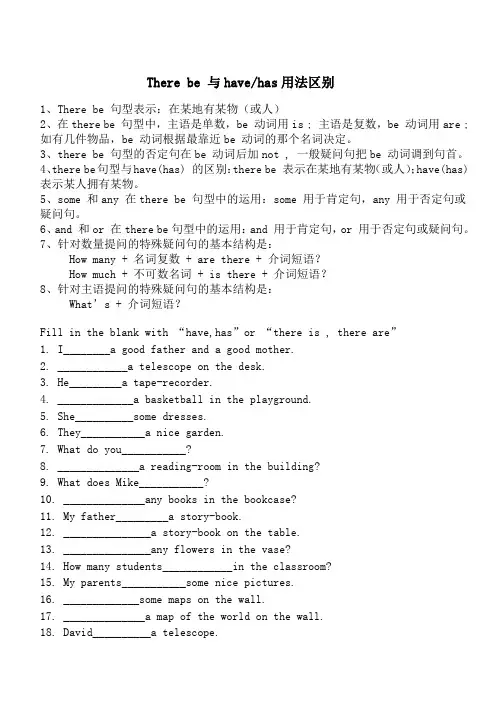
There be 与have/has用法区别1、There be 句型表示:在某地有某物(或人)2、在there be 句型中,主语是单数,be 动词用is ; 主语是复数,be 动词用are ; 如有几件物品,be 动词根据最靠近be 动词的那个名词决定。
3、there be 句型的否定句在be 动词后加not , 一般疑问句把be 动词调到句首。
4、there be句型与have(has) 的区别:there be 表示在某地有某物(或人);have(has) 表示某人拥有某物。
5、some 和any 在there be 句型中的运用:some 用于肯定句,any 用于否定句或疑问句。
6、and 和or 在there be句型中的运用:and 用于肯定句,or 用于否定句或疑问句。
7、针对数量提问的特殊疑问句的基本结构是:How many + 名词复数 + are there + 介词短语?How much + 不可数名词 + is there + 介词短语?8、针对主语提问的特殊疑问句的基本结构是:What’s + 介词短语?F ill in the blank with “have,has”or “there is , there are”1. I________a good father and a good mother.2. ____________a telescope on the desk.3. He_________a tape-recorder.4. _____________a basketball in the playground.5. She__________some dresses.6. They___________a nice garden.7. What do you___________?8. ______________a reading-room in the building?9. What does Mike___________?10. ______________any books in the bookcase?11. My father_________a story-book.12. _______________a story-book on the table.13. _______________any flowers in the vase?14. How many students____________in the classroom?15. My parents___________some nice pictures.16. _____________some maps on the wall.17. ______________a map of the world on the wall.18. David__________a telescope.19. David’s friends___________some tents.20. ______________many children on the hill.用恰当的be动词填空。
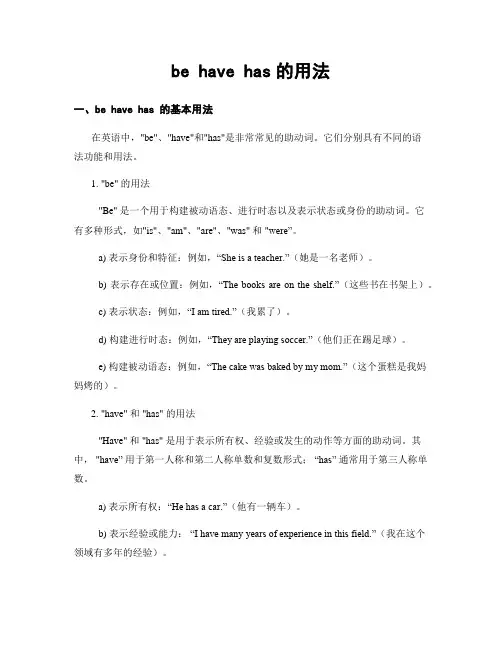
be have has的用法一、be have has 的基本用法在英语中,"be"、"have"和"has"是非常常见的助动词。
它们分别具有不同的语法功能和用法。
1. "be" 的用法"Be" 是一个用于构建被动语态、进行时态以及表示状态或身份的助动词。
它有多种形式,如"is"、"am"、"are"、"was" 和"were”。
a) 表示身份和特征:例如,“She is a teacher.”(她是一名老师)。
b) 表示存在或位置:例如,“The books are on the shelf.”(这些书在书架上)。
c) 表示状态:例如,“I am tired.”(我累了)。
d) 构建进行时态:例如,“They are playing soccer.”(他们正在踢足球)。
e) 构建被动语态:例如,“The cake was baked by my mom.”(这个蛋糕是我妈妈烤的)。
2. "have" 和 "has" 的用法"Have" 和 "has" 是用于表示所有权、经验或发生的动作等方面的助动词。
其中,"have” 用于第一人称和第二人称单数和复数形式;“has” 通常用于第三人称单数。
a) 表示所有权:“He has a car.”(他有一辆车)。
b) 表示经验或能力:“I have many years of experience in this field.”(我在这个领域有多年的经验)。
c) 表示发生的动作:“They have dinner at 7 o'clock every day.”(他们每天晚上七点吃饭)。
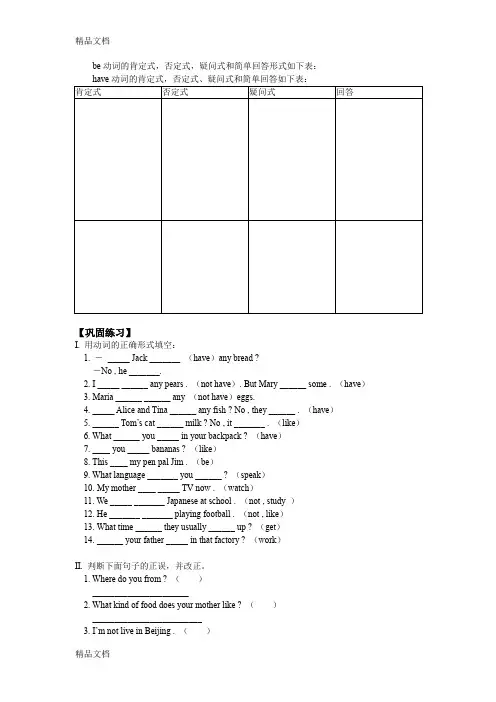
be动词的肯定式,否定式,疑问式和简单回答形式如下表:【巩固练习】I. 用动词的正确形式填空:1. -_____ Jack _______ (have)any bread ?-No , he _______.2. I _____ ______ any pears . (not have). But Mary ______ some . (have)3. Maria ______ ______ any (not have)eggs.4. _____ Alice and Tina ______ any fish ? No , they ______ . (have)5. ______ Tom’s cat ______ milk ? No , it _______ . (like)6. What ______ you _____ in your backpack ? (have)7. ____ you _____ bananas ? (like)8. This ____ my pen pal Jim . (be)9. What language _______ you ______ ? (speak)10. My mother ____ _____ TV now . (watch)11. We _____ _______ Japanese at school . (not , study )12. He _______ _______ playing football . (not , like)13. What time ______ they usually ______ up ? (get)14. ______ your father _____ in that factory ? (work)II. 判断下面句子的正误,并改正。
1. Where do you from ? ()______________________2. What kind of food does your mother like ? ()_________________________3. I’m not live in Beijing . ()_________________________4. My pen pal want to come here this September . ()_________________________5. The twins doesn’t like thrillers . ()_________________________a movie . ()_________________________7. Do your parents likes salad ? ()_________________________8. Does Jim and Mary in the same class ? ()_________________________III. 句型转换:1. School starts at 8 o’clock in the morning . (改为一般疑问句)____ school _____ at 8 o’clock in the morning ?2. My grandpa does sports every day . (改为否定句)My grandpa _____ ______ sports every day .3. How do you go to school ? (完成答句)I _____ to school by bike .4. Lin Hai works hard . (改为否定句)Lin Hai _____ _______ hard .5. My pen pal comes from Brazil . (就划线部分提问)______ ______ your pen pal ______ _______ ?6. Maria can speak Chinese and French . (就划线部分提问)______ ______ ______ Maria speak ?7. Uncle Bob has a big apartment . (改为一般疑问句)_____ Uncle Bob ______ a big apartment ?8. My grandma likes nice and vegetables for dinner . (就划线部分提问)_______ _______ your grandma like for dinner ?9. Rick likes math because he thinks it is interesting . (就划线部分提问)______ ______ Rick _____ math ?10. What time does Tom usually go to school ? (回答问题)He usually _______ to school _______ 7 o’clock .IV. 用括号中适当的词填空:1. Li Mei usually ______ (come , coming , comes)to school early .2. My English teacher ______ (is , plays , play)tennis well .3. _____ (Is , Do , Does)there a cinema in this area (地区)?4. _______(Are , Does , Do)they speak , English in Brazil ?5. It _______ (isn’t , don’t , doesn’t )often snow in winter .6. The girl _______ (go , goes , going)home at 4:30 in the afternoon .V. 选择填空:()1. Tom is a worker . He _____ in a factory . His sisters _____ in a hospital.A. work , workB. works , workC. work , works()2. Who ______ English best in your class ?A. speakB. speaksC. speaking()3. We _______ music and often _____ to music .A. like , listenB. likes , listensC. like , are listening()4. On Sunday he sometimes _____ his clothes and sometimes _____ some shopping.A. wash , doB. is washing , is doingC. washes , does()5. The twins usually _______ milk and bread for breakfast , but Jim ______ some oranges for it .A. have , haveB. have , hasC. has , haveVI. 用括号中所给动词的适当形式填空:Wang Lin 1 (be)a schoolboy . He 2 (live)in Beijing . He 3 (study)in a middle school.Wang Lin 4 (get)up at half past five every day . After that he 5 (read)English and Chinese . He 6 (have)breakfast at seven . Wang Lin 7 (go)to school six days a week . In class he 8 (listen)to the teacher carefully and his teachers 9 (like)him very much .VII. 阅读理解:(A)Mr. Brown is a very old man . Every morning he goes for a walk in the park . And he comes home at twelve thirty for his lunch .But today a car stops at his house at twelve o’clock . Two policemen help him get out . One of them says to Mr. Brown’s daughter :“The old man can’t find his way in the park . He asks us to take him home in the car . ”The daughter thanks the policemen and they leave . Then she asks his father : “Dad , you goes to that park every day . But today , you can’t find the way . What’s wrong with you ? ”The old man smiles like a child and says : “I can find my way . I don’t want to walk h ome , you know . ”()1. Every morning Mr. Brown often comes home at _____.A. twelveB. elevenC. twelve thirtyD. twelve ten()2. Today Mr. Brown comes home by _____.A. busB. carC. bikeD. boat()3. The policeman says Mr. Brown ________ in the park.A. doesn’t want to walk homeB. can’t find his wayC. find his wayD. knows the way()4. Mr. Brown’s daughter thinks ______.A. he wants to go homeB. he wants to have lunch earlyC. he doe sn’t want to go to the parkD. something is wrong with him()5. Mr. Brown has lunch ______.A. in the parkB. at homeC. in the carD. at twelve(B)Tom lives and works in London . He works hard from Monday to Friday . On Saturday and Sunday he doesn’t go to work . Sometimes he goes shopping . Sometimes he goes to see his friends . This week he is going to Birminghan (伯明翰市)with his good friend Mike . They are going to see their friends there . This is what they are going to do .They are going to take the 2:40 train on Friday afternoon . In Birminghan , Tom’s friend , Jack is going to take them home in his car . Tom and Mike are going to stay with Jack for the weekend .On Saturday morning Jack is going to take them to a m iddle school . Mike’s friend , Mr . White is a teacher there .On Sunday , Jack is going to take them to some nice parks in Birminghan . They are going to take the 6:00 train back to London .()1. On ______ afternoon Tom and Mike are going to take the 2:40 train .A. FridayB. SaturdayC. SundayD. Monday()2. Jack is going to ______ them home in his car .A. carryB. look afterC. meetD. take()3. Mr. White is a ________ of a middle school.A. studentB. teacherC. classmateD. pupil()4. Tom and Mike are going to ______ with Jack for the weekend .A. liveB. stayC. talkD. ride()5. Tom and Mike are going to take the _______ train back to London .A. 7:00B. 6:00C. 6:30D. 7:30 轻松一刻:I can see it , but you can’t .What is it ?【练习答案】I.1. Does , have , doesn’t2. don’t , have , has3. doesn’t , have4. Do , have , don’t5. Does , like , doesn’t6. do , have7. Do , like 8. is9. do , speak 10. is , watching11. don’t , study12. doesn’t , like13. do , get 14. Does , workII.1. do 改为are2. √3. in 改为do4. want后加s5. doesn’t 改为don’t6. don’t改为doesn’t7. likes改为like 8. Does改为DoIII. 1. Does , start 2. doesn’t , do3. go4. doesn’t , work5. Where , does , come , from6. What language (s)can Maria speak ?7. Does , have 8. What ,does9. Why , does , like10. goes , atIV. 1. comes 2. plays 3. Is 4. Do 5. doesn’t 6. goes V. 1. B 2. B 3. A 4. C 5. BVI. 1. is 2. lives 3. studies 4. gets 5. reads 6. has 7. goes 8. listens 9. likeVII. A. 1-5 CBBDBB. 1-5 ADBBB猜谜语:答案是:the back of your head。
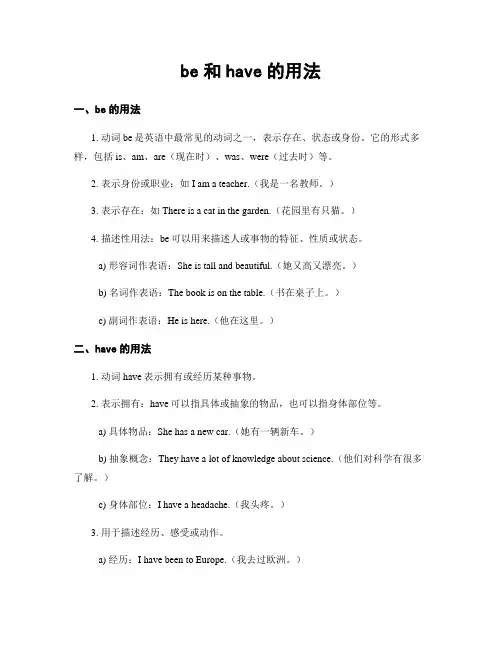
be和have的用法一、be的用法1. 动词be是英语中最常见的动词之一,表示存在、状态或身份。
它的形式多样,包括is、am、are(现在时)、was、were(过去时)等。
2. 表示身份或职业:如I am a teacher.(我是一名教师。
)3. 表示存在:如There is a cat in the garden.(花园里有只猫。
)4. 描述性用法:be可以用来描述人或事物的特征、性质或状态。
a) 形容词作表语:She is tall and beautiful.(她又高又漂亮。
)b) 名词作表语:The book is on the table.(书在桌子上。
)c) 副词作表语:He is here.(他在这里。
)二、have的用法1. 动词have表示拥有或经历某种事物。
2. 表示拥有:have可以指具体或抽象的物品,也可以指身体部位等。
a) 具体物品:She has a new car.(她有一辆新车。
)b) 抽象概念:They have a lot of knowledge about science.(他们对科学有很多了解。
)c) 身体部位:I have a headache.(我头疼。
)3. 用于描述经历、感受或动作。
a) 经历:I have been to Europe.(我去过欧洲。
)b) 感受:He has a great time at the party.(他在聚会上玩得很开心。
)c) 动作:We have a meeting tomorrow.(我们明天开会。
)三、be和have的强调形式除了常规用法外,be和have可以通过添加助动词或使用其他语法结构来强调意思。
1. be的强调形式:a) 表示习惯或性质:She is always late for class.(她总是上课迟到。
)b) 表示目的、原因或结果:The book is to help you study better.(这本书是帮助你更好地学习的。
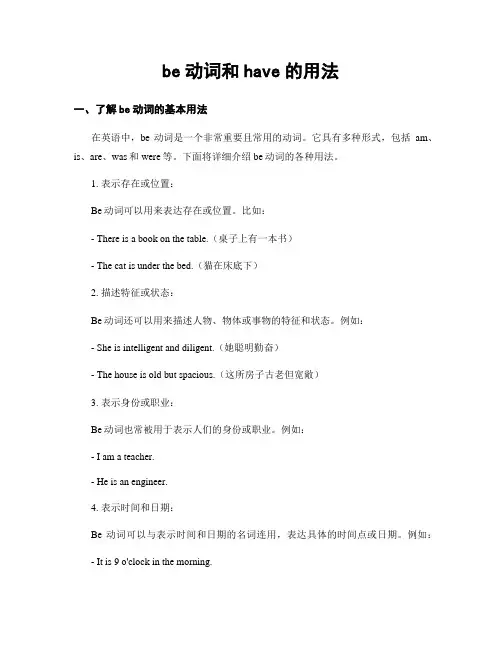
be动词和have的用法一、了解be动词的基本用法在英语中,be动词是一个非常重要且常用的动词。
它具有多种形式,包括am、is、are、was和were等。
下面将详细介绍be动词的各种用法。
1. 表示存在或位置:Be动词可以用来表达存在或位置。
比如:- There is a book on the table.(桌子上有一本书)- The cat is under the bed.(猫在床底下)2. 描述特征或状态:Be动词还可以用来描述人物、物体或事物的特征和状态。
例如:- She is intelligent and diligent.(她聪明勤奋)- The house is old but spacious.(这所房子古老但宽敞)3. 表示身份或职业:Be动词也常被用于表示人们的身份或职业。
例如:- I am a teacher.- He is an engineer.4. 表示时间和日期:Be动词可以与表示时间和日期的名词连用,表达具体的时间点或日期。
例如:- It is 9 o'clock in the morning.- Today is Monday.5. 构成进行时态:Be动词配合进行时态,表示正在进行的动作。
例如:- They are playing football in the park.- We were studying English last night.二、掌握have的常见使用方式除了be动词外,另一个常用的动词是have。
以下将介绍have动词的几种常见用法。
1. 表示拥有:Have可用来表示某人或某物拥有某样东西。
例如:- I have a car and a bicycle.- They have three children.2. 表示经历:Have还可以表示经历某件事情或遭遇到某种状况。
例如:- She had a wonderful holiday in Bali.- We have had some difficulties in the past.3. 表示进行某种活动:Have也可用于表示进行某种活动。
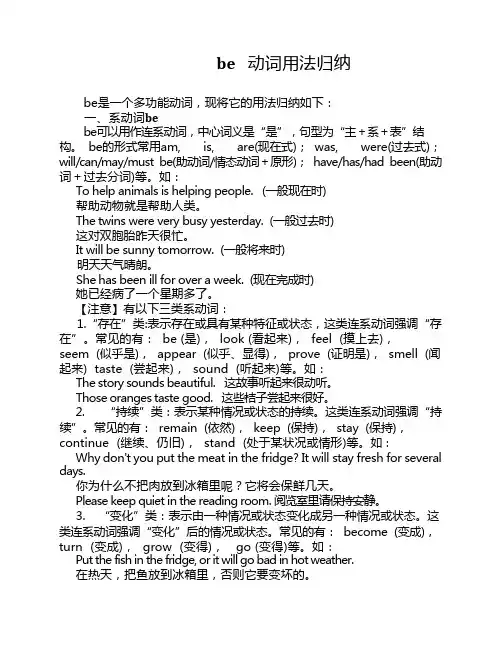
be动词用法归纳be是一个多功能动词,现将它的用法归纳如下:一、系动词bebe可以用作连系动词,中心词义是“是”,句型为“主+系+表”结构。
be的形式常用am, is, are(现在式); was, were(过去式);will/can/may/must be(助动词/情态动词+原形); have/has/had been(助动词+过去分词)等。
如:To help animals is helping people. (一般现在时)帮助动物就是帮助人类。
The twins were very busy yesterday. (一般过去时)这对双胞胎昨天很忙。
It will be sunny tomorrow. (一般将来时)明天天气晴朗。
She has been ill for over a week. (现在完成时)她已经病了一个星期多了。
【注意】有以下三类系动词:1.“存在”类:表示存在或具有某种特征或状态,这类连系动词强调“存在”。
常见的有: be (是), look (看起来), feel (摸上去),seem (似乎是), appear (似乎、显得), prove (证明是), smell (闻起来) taste (尝起来), sound (听起来)等。
如:The story sounds beautiful. 这故事听起来很动听。
Those oranges taste good. 这些桔子尝起来很好。
2. “持续”类:表示某种情况或状态的持续。
这类连系动词强调“持续”。
常见的有: remain (依然), keep (保持), stay (保持),continue (继续、仍旧), stand (处于某状况或情形)等。
如 : Why don't you put the meat in the fridge? It will stay fresh for several days.你为什么不把肉放到冰箱里呢?它将会保鲜几天。
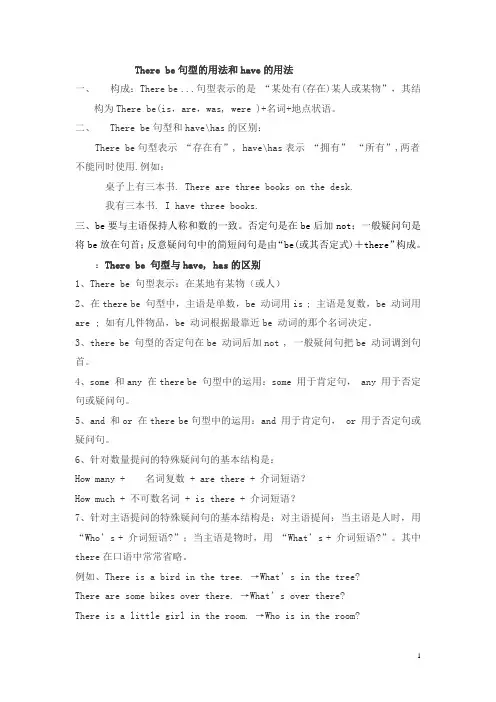
There be句型的用法和have的用法一、构成:There be ...句型表示的是“某处有(存在)某人或某物”,其结构为There be(is,are,was, were )+名词+地点状语。
二、There be句型和have\has的区别:There be句型表示“存在有”, have\has表示“拥有” “所有”,两者不能同时使用.例如:桌子上有三本书. There are three books on the desk.我有三本书. I have three books.三、be要与主语保持人称和数的一致。
否定句是在be后加not;一般疑问句是将be放在句首;反意疑问句中的简短问句是由“be(或其否定式)+there”构成。
:There be 句型与have, has的区别1、There be 句型表示:在某地有某物(或人)2、在there be 句型中,主语是单数,be 动词用is ; 主语是复数,be 动词用are ; 如有几件物品,be 动词根据最靠近be 动词的那个名词决定。
3、there be 句型的否定句在be 动词后加not , 一般疑问句把be 动词调到句首。
4、some 和any 在there be 句型中的运用:some 用于肯定句, any 用于否定句或疑问句。
5、and 和or 在there be句型中的运用:and 用于肯定句, or 用于否定句或疑问句。
6、针对数量提问的特殊疑问句的基本结构是:How many + 名词复数 + are there + 介词短语?How much + 不可数名词 + is there + 介词短语?7、针对主语提问的特殊疑问句的基本结构是:对主语提问:当主语是人时,用“Who’s + 介词短语?”;当主语是物时,用“What’s + 介词短语?”。
其中there在口语中常常省略。
例如、There is a bird in the tree. →What’s in the tree?There are some bikes over there. →What’s over there?There is a little girl in the room. →Who is in the room?8、对地点状语提问:用“Where is \ are + 主语?”表示(注意其答语变化There is a computer in my office.→ Where is the computer? ----It’s in my office.There are four children in the classroom.→Where are the four children?—They’ re in the classroom9、对数量提问:一般有两种提问方式:如果主语是可数名词,无论是单数还是复数,都用“How many +可数名词复数 + are there + 介词短语?”表示:There are twelve months in a year.→How many months are there in a year?There is only one book in my bag.→ How many books are there in your bag?There is a cat in the box.→ How many cats are there in the box?10、如果主语是不可数名词,则用“ How much + 不可数名词 + is there + 介词短语?”表示:There is some money in my purse.How much money is there in your purse?练习翻译下面句子1、我有一本书。

be动词和have的用法区别1. 介绍在英语中,be动词和have都是常见的基本动词,它们在句子中具有不同的功能和含义。
本文将详细讨论be动词和have的用法区别,以帮助读者更好地理解和运用这两个动词。
2. be动词的用法2.1 表示状态或性质be动词经常用来表示一个人或事物的状态或性质。
例如:- She is happy.(她很快乐。
)- The cat is white.(这只猫是白色的。
)2.2 表示身份、职业等be动词还可以用来表示一个人的身份、职业等。
例如:- He is a doctor.(他是一名医生。
)- They are students.(他们是学生。
)3. have的用法3.1 拥有某物have常常用于表示一个人拥有某个物品或概念。
例如:- I have a car.(我有一辆车。
)- She has two brothers.(她有两个兄弟。
)3.2 经历、体验或感受have还可表示经历、体验或感受某事物。
例如:- We had a great time at the party.(我们在派对上玩得很开心。
)- He has a headache.(他头疼。
)4. 区别总结4.1 主语不同be动词后面接主语,表示主语的状态或属性;而have后面接宾语,表示主语拥有某物。
4.2 用法不同be动词常用于句子中作为谓语动词,表示主语的状态或性质;而have既可以作为谓语动词,也可以作为助动词形成完成时等时态。
4.3 意义不同be动词表达一个人或事物的状态或性质;而have则强调拥有、经历、体验或感受某事物。
5. 示例- She is happy because she has a good job and a loving family.(她因为有一份好工作和一个充满爱的家庭所以快乐。
)在这个例子中,be动词is表达了她的快乐状态,而have则表示她拥有一份工作和一个家庭。
6. 结论在英语中,be动词和have是非常基础且重要的两个动词。
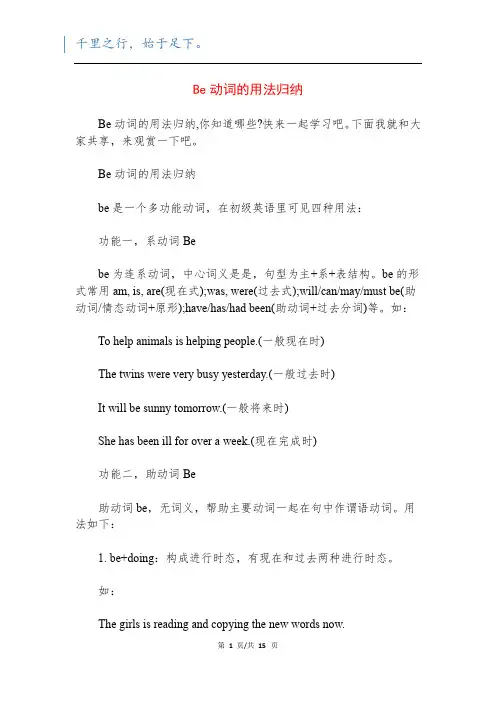
Be动词的用法归纳Be动词的用法归纳,你知道哪些?快来一起学习吧。
下面我就和大家共享,来观赏一下吧。
Be动词的用法归纳be是一个多功能动词,在初级英语里可见四种用法:功能一,系动词Bebe为连系动词,中心词义是是,句型为主+系+表结构。
be的形式常用am, is, are(现在式);was, were(过去式);will/can/may/must be(助动词/情态动词+原形);have/has/had been(助动词+过去分词)等。
如:To help animals is helping people.(一般现在时)The twins were very busy yesterday.(一般过去时)It will be sunny tomorrow.(一般将来时)She has been ill for over a week.(现在完成时)功能二,助动词Be助动词be,无词义,帮助主要动词一起在句中作谓语动词。
用法如下:1. be+doing:构成进行时态,有现在和过去两种进行时态。
如:The girls is reading and copying the new words now.Young Tom was always asking questions and trying out new ideas.2. be+done:构成被动语态(主语是动作的承受者,done必需是及物动词)。
如:Tea is grown in my hometown.(一般现在时的被动语态)This building was built three years ago.(一般过去时的被动语态)Our classroom has been cleaned and tidied already.(现在完成时的被动语态)How could this kind of cakes be made in your home?(含情态动词的被动语态)That is a day never to be forgotten.(动词不定式的被动语态)3. be+going to do,表示准备或将要做某事,be有现在和过去两种形式。
B e动词a m,i s.a r e总结以及h a v e 和h a s用法总结一、Be动词有am, is, are三个,用法如下:1. 我用am,即 I am ... “I”(我)一般情况大写例句:(1) Hello, I am a boy. I am 7 years old this year.(2) Good morning, Miss Li. I am Su Hai.2.他她它后用is, 即He is ..., She is ..., It is ... 此外,表示一个人或者一个物的词,相当于He, She和It,后边的be动词也用is。
例句:用He, She, It, am, is, are填空(1) Look at the girl. She is cute.(2) Look at the boy. He is cute.(3)Look at the bear. It is brown.(4)My brother is tall. He is 28 years old.(5)My sister is lovely. She is beautiful.(6)The hamster is small. It is brown.(7)The giraffe is tall. It is yellow and brown.3.你,你们,他们,我们,表示多个人或者多个物的词后边的be动词用are,即: You are ..., You are ..., They are ..., We are ..., ...s are ...(1) You are a good man.(你)(2) You all like eating apples.(你们)(3) Look at the bears.(熊) They have short tails. They are brown.(他们)(4) You like pears. I like pears. We all like pears.(我们)(5) Many boys fly kites in the park. They are happy.(多个人)(6) Lots of girls dance in the classroom. They are happy, too.(多个人)(7) My bags are colorful. They are nice. (多个物)(8) The pandas are white and black. They are cute.(多个物)二、have和has的用法1.他她它后用has, 即He has ..., She has ..., It has ... 此外,表示一个人或者一个物的词,相当于He, She和It,后边也用has例句:用have或者has,He, She或者It填空(1) Look at the girl. She is cute. She has two big eyes.(2) Look at the boy. He is cute. He has a beautiful toy car.(3) Look at the bear. It is brown. It has a short tail.(4) My brother has a toy car.(表示人) He gives it to me.(5) My sister has long hair.(表示人) She is cute(6) The hamster has a short tail.(表示物) It is small.(7) The giraffe has a long neck.(表示物) It is tall.2.我,你,你们,他们,我们,表示多个人或者多个物的词后边用have,即:I have ..., You have ..., You have ..., They have ..., We have ..., ...s have ...例句:用have或者has填空(1) I have many green pencils.(我有)(2) You have a good book.(你有)(3) You have some juicy oranges.(你们有)(4) Look at the tigers. They have long tails.(他们有)(5) You have pumpkins. I have pumpkins. We all have pumpkins(我们有)(6) Many girls have long hair.(很多人有)(7) The hamsters have short tails.(很多个物有)。
让知识带有温度。
关于be动词的用法整理关于be动词的用法be动词的用法1、当做主动词时,“be”在性质上属于接系动词(The Linking Verb), 后面要出名词、形容词、地方副词或短语作补足语(The Complement)。
2、陈述句,可以变成疑问句,方法简洁,把主语和“be”或助动词对换位置即可。
3、当“be”要在祈使句中消失时,陈述句可借助助动词“do”,否定句必需在前加上助动词“dont”。
向左转|向右转4、“Be”有两种缩写法,但“am + not”的缩写法只有一个。
5、“Be + 现在分词”以组成进行式时态(Continuous Tenses)。
6、被动语态的基本结构为be+done(Be动词+动词过去分词)7、一般现在时:am/is/are+done8、一般过去时:was/were+done9、一般将来时:will+be+done10、现在进行时:am/is/are+being+done第1页/共2页千里之行,始于足下。
11、过去进行时:was/were+being+done12、现在完成时:have/has+been+done13、过去完成时:had+been+donebe动词应用规律一般现在时:我是is ,你是are,is跟着他她它。
一般过去式:单数was,复数were,if虚拟都用were.表示被动:be+done, has been done现在分词结构在句首:being+adj.或过去分词Be动词的用法口诀我用am,你用are,is连着他,她,它; 单数名词用is,复数名词全用are。
变疑问,往前提,句末问号莫丢弃。
变否定,更简单,be后not莫遗忘。
疑问否定任你变,句首大写莫迟疑。
文档内容到此结束,欢迎大家下载、修改、丰富并分享给更多有需要的人。
第2页/共2页。
have和be的用法区别一、have和be的基本用法区别在英语中,have和be是两个常见的动词,它们有着不同的用法和含义。
下面将详细介绍这两个动词的基本用法区别。
1. 表示所拥有的物品或属性:- have:表示拥有、具备或持有某种物品、财富或属性。
例如:"I have a car."(我有一辆汽车)"She has beautiful hair."(她有漂亮的头发)- be:用于描述人或事物所具备的特定性质或状态。
例如:"They are intelligent."(他们聪明)"The sky is blue."(天空是蓝色的)2. 表示已经发生或存在过的动作或状态:- have:表示已经完成或经历过某件事情。
例如:"He has visited Paris."(他去过巴黎)"I have seen that movie before."(我以前看过那部电影)- be:表示当前的状态或处于某种特定条件下。
例如:"She is happy today."(今天她很开心)"They are married."(他们结婚了)3. 表示行为动作或能力:- have:表示进行某项行为活动,强调主语参与到该行为中。
例如:"I have breakfast every morning."(我每天早上吃早餐)"She has a shower before bed."(睡觉前她洗个淋浴)- be:表示具有某种能力或进行特定活动,强调主语本身具备这种特质。
例如:"He is good at playing the guitar."(他擅长弹吉他)"She is a fast runner."(她是一个快速的跑者)4. 表示情感、感受或存在:- have:表示拥有某种情感、感受或经历某种情况。